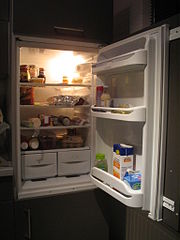Description
In our house we all have at least one fridge, and furthermore, in the different departments and offices of the university we can find a large number of fridges, used both to preserve food and products used in research (chemical products, biological samples, etc.). A good use of these appliances can help to reduce their energy consumption.
What can I do?
 Do not open the fridge unnecessarily and close the door as quickly as possible.
Do not open the fridge unnecessarily and close the door as quickly as possible.- Do not put hot products inside. Let them cool first outside the fridge.
- If you defrost food inside the fridge, you can save energy thanks to the extra supply of cold.
- In order for the refrigerator to work properly, it is necessary to cover the containers that hold liquid products and foodstuffs must be placed inside the appliance in order to avoid an increase in humidity inside the appliance. This prevents the compressor from having to work harder and, therefore, the electrical consumption from increasing.
- Place the refrigerator away from heat sources or direct sunlight in order to reduce its energy consumption. It must also be 5 cm away from the wall.
- Set the refrigerator thermostat to 6 °C and the freezer thermostat to -18 °C, unless the products you are storing have other requirements.
- Defrost the fridge regularly to prevent the ice layer from exceeding 5 mm, thus saving between 20-30% energy. If you have to renew the appliance, choose a No Frost model that prevents the formation of ice.
- Check that the refrigerator door seals are in good condition and that they allow the refrigerator door to close properly.
- When you need to replace your fridge, select a low-consumption model. On the efficiency label you will find the energy classification of the appliance and its consumption. Remember that the letter A, followed by the symbol +, identifies the most efficient appliances (refrigerators with lower consumption have additional + symbols).
Impact on the environment

*Image: Open refrigerator. By: M. Minderhoud [GFDL o CC-BY-SA-3.0], via the Wikimedia Commons.